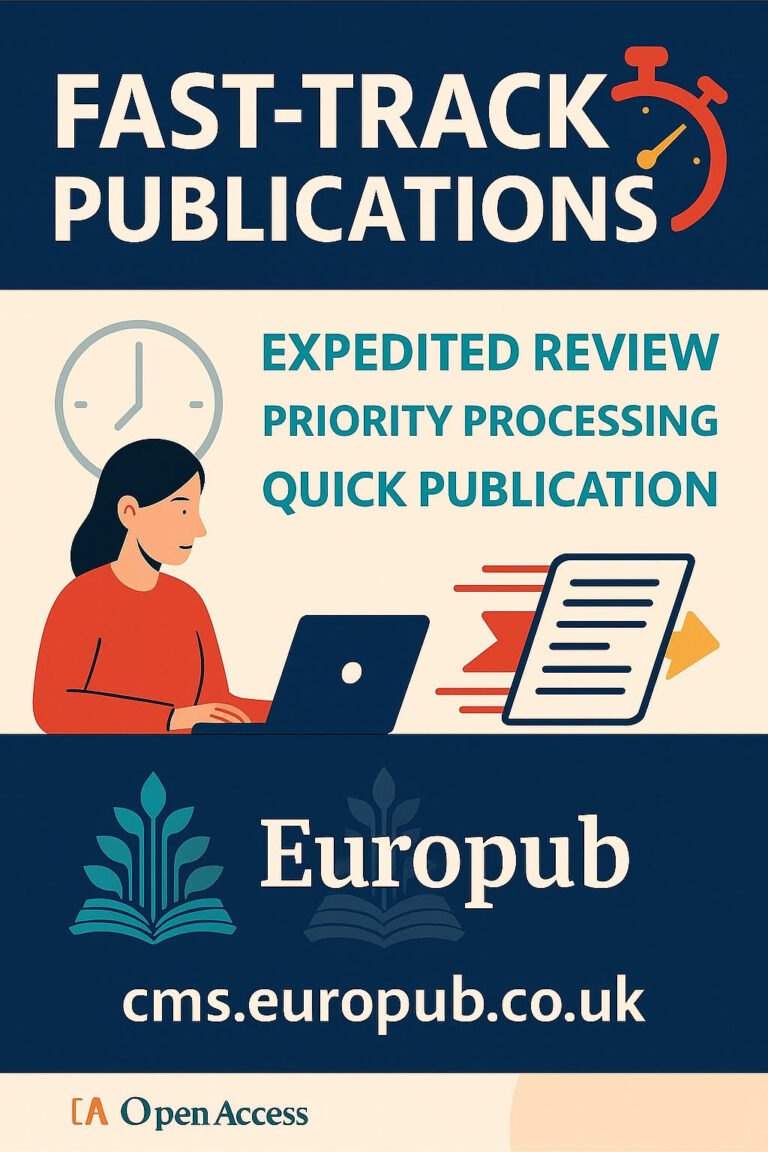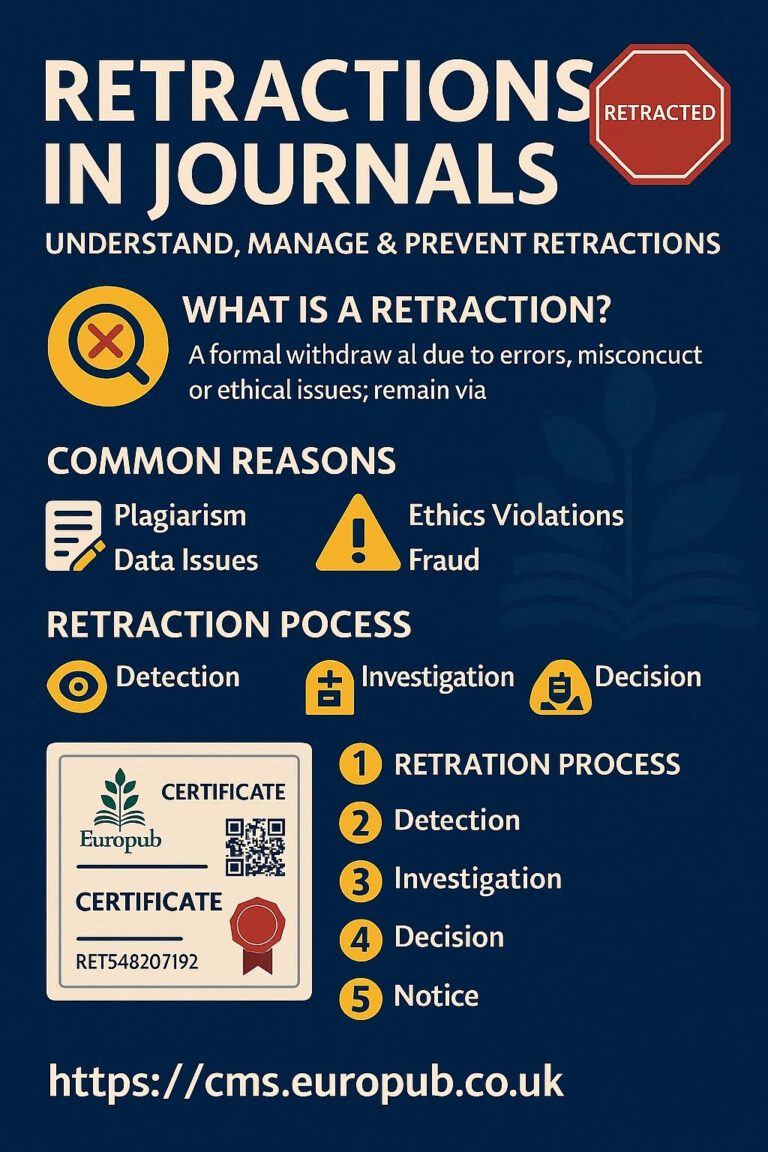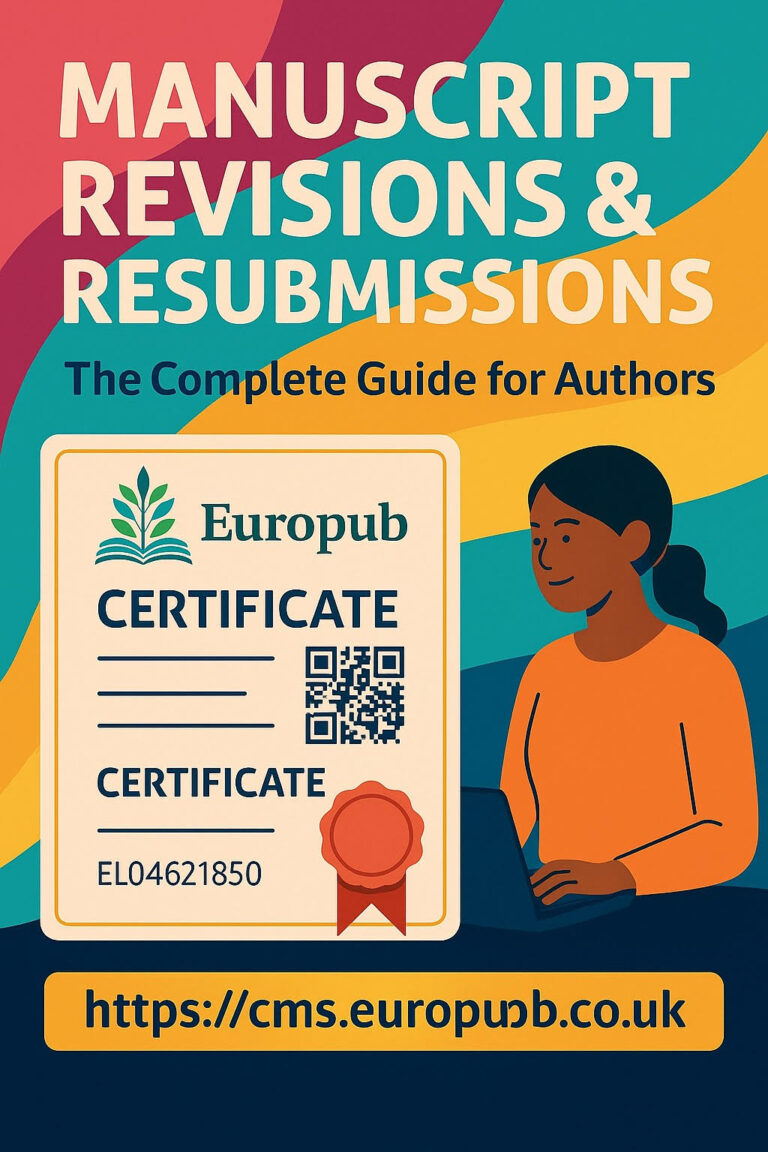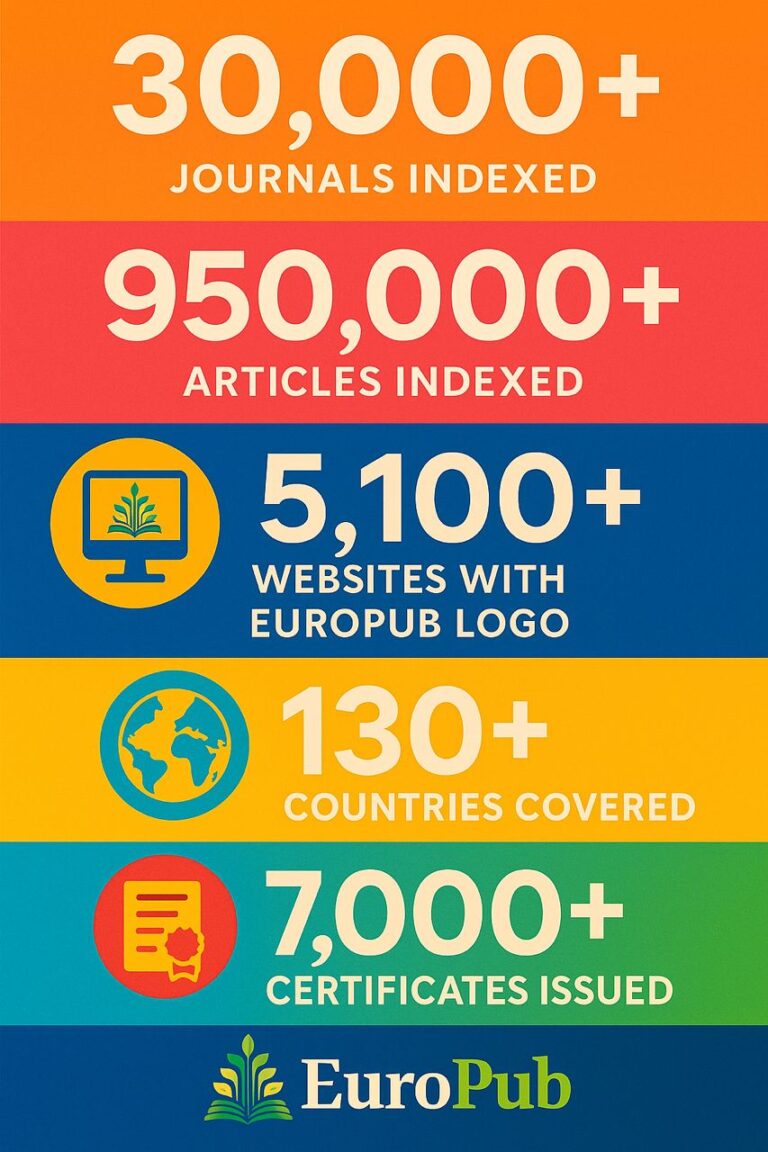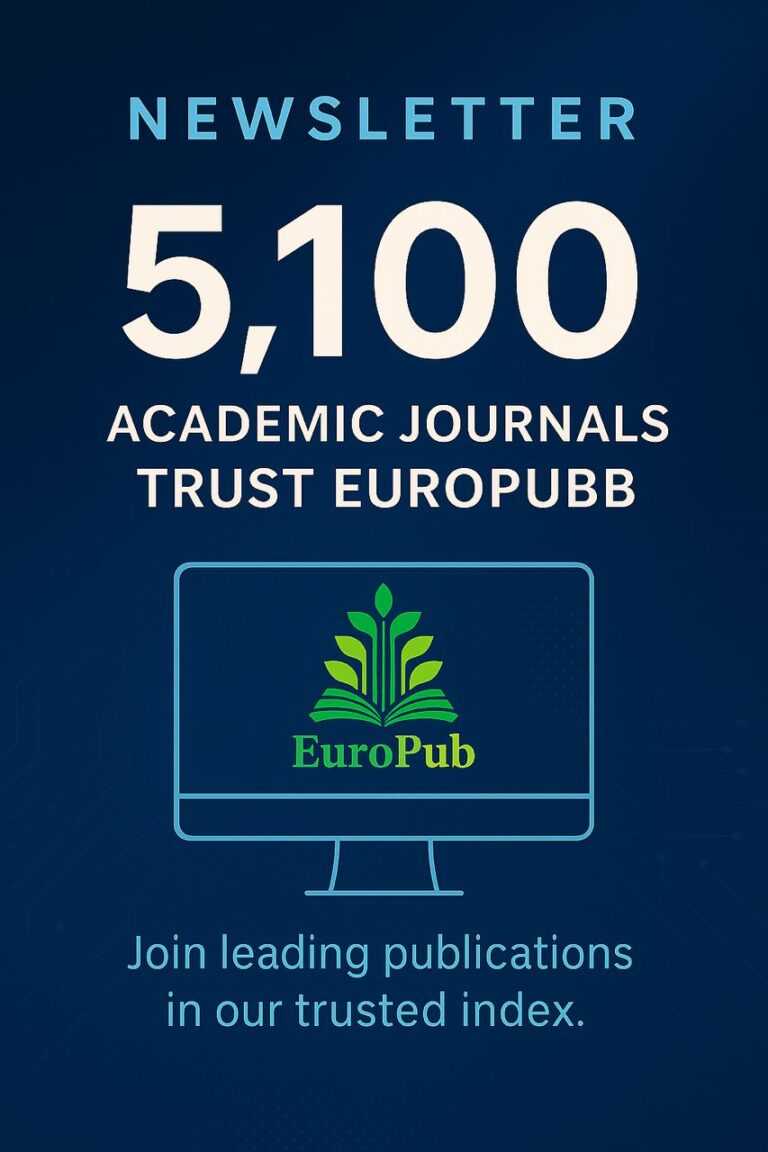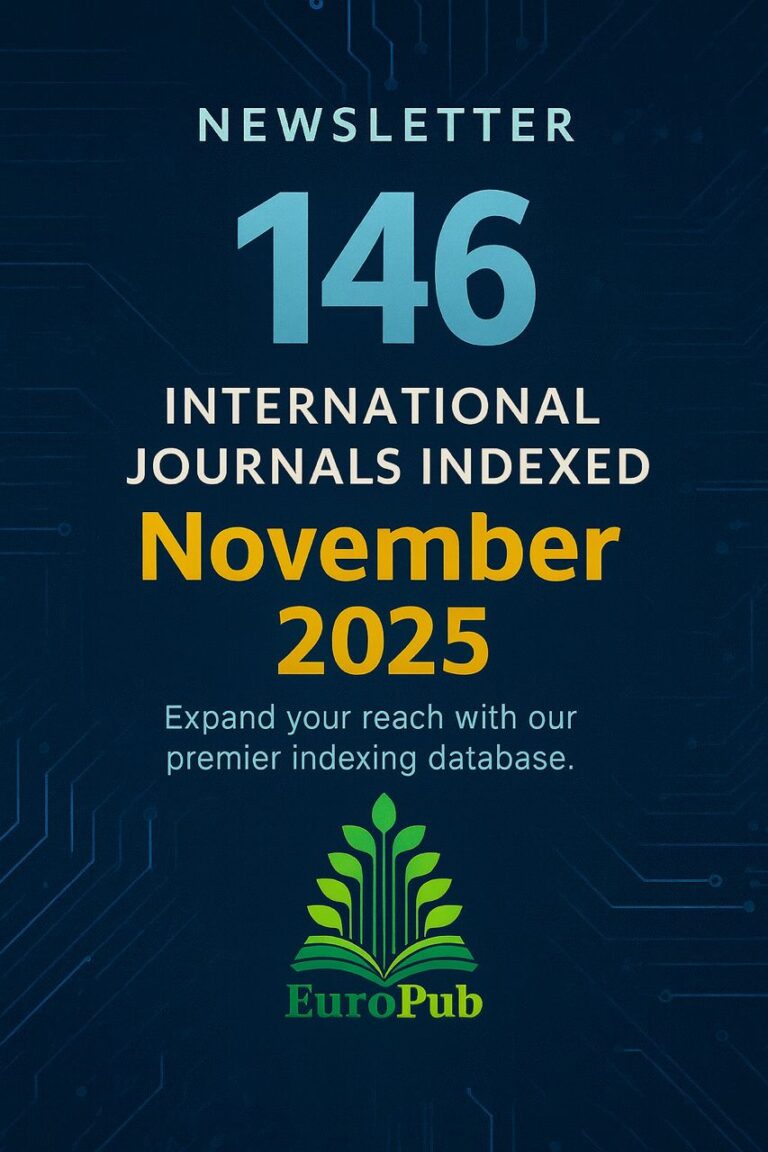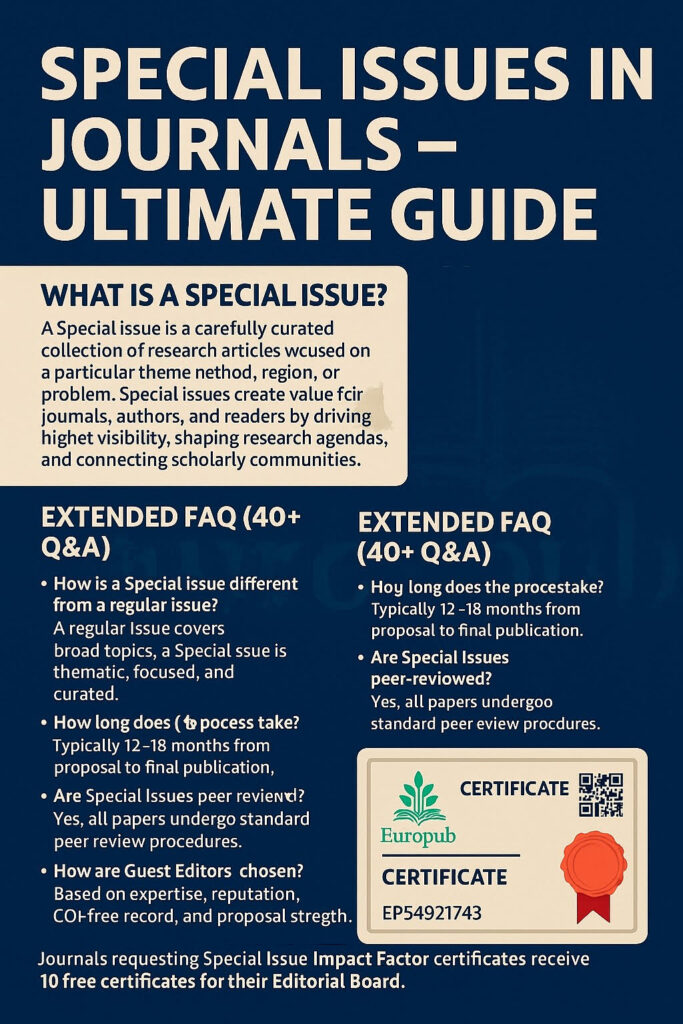
What is a Special Issue?
A Special Issue (SI) is a carefully curated collection of research articles focused on a particular theme, method, region, or problem. It is typically:
- Guest-edited by recognized scholars.
- Announced through a Call for Papers (CFP) with strict timelines.
- Published either within regular issues or as a standalone volume.
Special Issues create value for journals, authors, and readers by driving higher visibility, shaping research agendas, and connecting scholarly communities.
Why Do Journals Publish Special Issues?
- Content leadership — spotlight emerging areas.
- Community building — foster collaboration among institutions, networks, and societies.
- Growth — boost submissions, readership, citations, and media attention.
- Diversity — bring in new regions, methods, and early-career voices.
- Publisher value — enrich the backlist and attract partnerships.
Types of Special Issues
- Thematic (e.g., AI in Healthcare).
- Methodological (new techniques, protocols).
- Regional/Contextual (focus on MENA, Asia-Pacific, etc.).
- Data-driven (benchmark datasets, shared protocols).
- Anniversary/Tribute (celebrating scholars or milestones).
- Conference-linked (invited, expanded papers).
- Policy/Practice (industry, government, NGO cross-links).
Workflow (Step-by-Step)
- Idea & scoping — define a timely theme.
- Proposal — include rationale, Guest Editors, CFP draft.
- Evaluation — EiC and board review for novelty and fit.
- Approval & scheduling — assign workflows, set deadlines.
- CFP launch — announce on journal website, lists, social media.
- Submission & screening — check plagiarism, scope, ethics.
- Peer review — robust, independent, COI managed.
- Revision & decision — EiC retains final say.
- Production — editing, typesetting, DOI assignment.
- Launch — online publication, webinars, press, social media.
- Post-publication analysis — metrics, downloads, citations.
Key Roles
- EiC — final authority, approves SI.
- Guest Editors — manage CFP, peer review, editorial.
- Managing Editors — workflow, ethics, checks.
- Reviewers — impartial expert evaluations.
- Authors — timely submission, compliance with ethics.
- Publisher — production, indexing, marketing.
Ethics & Integrity
- COPE-compliance mandatory.
- Guest Editors cannot decide on their own papers.
- Diversity in reviewers and authorship is required.
- Citation manipulation prohibited.
- Transparency — publish editorial with full handling statement.
Discoverability & Indexing
- Indexed as part of regular journal issues (Scopus, Web of Science, PubMed, DOAJ).
- Strong metadata: ORCID, funder IDs, dataset DOIs.
- OA compliance with funder mandates.
- Consistent use of DOIs and collection tags.
Success Metrics
- Submissions received.
- Acceptance rates.
- Time to decision/publication.
- Downloads, readers, citations.
- Altmetric and social mentions.
- Diversity of contributors.
- Satisfaction surveys.
Extended FAQ (40+ Q&A)
Q1. How is a Special Issue different from a regular issue?
A regular issue covers broad topics; a Special Issue is thematic, focused, and curated.
Q2. Who can propose a Special Issue?
Usually Guest Editors (renowned researchers), societies, or editorial board members.
Q3. How long does the process take?
Typically 12–18 months from proposal to final publication.
Q4. Can early-career researchers act as Guest Editors?
Yes, if paired with experienced co-editors for balance.
Q5. Are Special Issues peer-reviewed?
Yes, all papers undergo standard peer review procedures.
Q6. How many articles are in a Special Issue?
Usually 8–20, depending on journal policy.
Q7. How are Guest Editors chosen?
Based on expertise, reputation, COI-free record, and proposal strength.
Q8. Can Guest Editors submit their own papers?
Yes, but these must be handled by an independent editor.
Q9. What makes a strong proposal?
Novelty, scope relevance, diverse Guest Editors, clear CFP.
Q10. What risks exist in running an SI?
Scope drift, reviewer shortages, citation manipulation, delays.
Q11. How are deadlines managed?
CFP, submission, and review deadlines are strictly enforced.
Q12. Are Special Issues indexed separately?
No, but tagged for visibility within indexing systems.
Q13. Can an SI be open access?
Yes, depending on the journal model (OA, hybrid, subscription).
Q14. Do authors pay APCs for SI?
Yes, if the journal is OA; waivers may be available.
Q15. How do publishers promote SIs?
Through websites, social media, newsletters, conferences.
Q16. How are reviewers selected?
At least two independent, diverse, international experts.
Q17. Can reviewers be reused from regular issues?
Yes, but diversity and expertise matching is encouraged.
Q18. Are SIs more cited than regular issues?
Often yes, due to thematic focus and community attention.
Q19. What if submissions are too few?
The SI may be merged with a regular issue.
Q20. How are conflicts of interest managed?
Guest Editors cannot review or decide on their own/co-author papers.
Q21. What role does the EiC play?
EiC approves proposals, oversees integrity, makes final decisions.
Q22. Are SIs permanent?
Yes, once published, they remain in the archive indefinitely.
Q23. Can societies or conferences sponsor SIs?
Yes, partnerships are common and strategic.
Q24. Can SIs include review articles?
Yes, alongside original research, methods, and data papers.
Q25. Can an SI span multiple volumes?
Usually not; but some journals allow extended collections.
Q26. How are Guest Editors acknowledged?
They are listed in the SI, often with an editorial piece.
Q27. Can multiple SIs run simultaneously?
Yes, depending on journal capacity.
Q28. How is plagiarism checked?
All submissions pass through standard plagiarism tools.
Q29. Can industry co-edit SIs?
Yes, if transparently declared and COPE guidelines are followed.
Q30. How do SIs affect journal metrics?
They typically increase citations and downloads.
Q31. Do all journals accept SI proposals?
No, only those with editorial policies allowing them.
Q32. How do authors find active SI Calls?
Via publisher websites, CFP portals, mailing lists.
Q33. What happens if Guest Editors miss deadlines?
EiC or Managing Editors may take over the process.
Q34. Are data and code sharing mandatory?
Yes, in many disciplines and OA journals.
Q35. Can SIs be interdisciplinary?
Yes, interdisciplinary SIs are encouraged.
Q36. Are SIs cited differently?
No, citation style remains the same.
Q37. What are typical rejection rates?
Similar to the journal’s average (often 40–70%).
Q38. Can Special Issues fail?
Yes, if poorly scoped, under-promoted, or mismanaged.
Q39. What happens after an SI closes?
Papers go through production, indexing, and post-publication tracking.
Q40. Are SIs suitable for young researchers to publish in?
Yes, they provide visibility, but quality expectations are high.
Useful Links
 Promotional note: Journals requesting Special Issue Impact Factor certificates receive 10 free certificates for their Editorial Board via Europub’s certification platform.
Promotional note: Journals requesting Special Issue Impact Factor certificates receive 10 free certificates for their Editorial Board via Europub’s certification platform.

